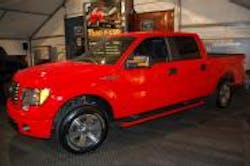“All of you know we’ve been on a journey for the last five years to be the leader in fuel economy with every vehicle we bring to market, and we’re putting our money where our mouth is.” –Frank Davis, executive director of North American product, Ford Motor Co.
Those are some big words, to say the very least, when it comes to discussing fuel economy – especially in the pickup truck arena.
But Ford believes it’s got a winning package second to none for its long-established F-150 pickup model – an engine capable of offering power to spare for any commercial operator, yet with a sleek fuel economy profile comparable to a sedan, if you can believe it.
Today I’m going to put those claims to the test out on the road as well as the impromptu test track Ford’s crafted from one of the parking lots surrounding the Texas Motor Speedway, located some 45 minutes outside of Dallas, TX.
The big gamble for Ford in the F-150 pickup segment revolves around the “EcoBoost” engine model; a base engine platform the company expects will be available in 90% of its North American product by 2013 and account for projected sales of 1.5 million units globally.
Jim Mazuchowski, Ford’s V6 engines program manager, told me the EcoBoost is designed to put a V6 engine in place of a V8, with a V8’s performance yet a V6’s fuel economy profile. “We’re trying to deliver the best of both world’s here; more power yet better fuel economy as well,” he explained.
For example, he noted it boasts vastly improved performance versus the 4.2 liter V6 it helps replace, generating 163 more hp and 168 added ft-lbs of torque. That improves the towing and payload carrying capability of the 2011 model F-150, Mazuchowski said, to 11,300 lbs and 3,060 lbs, respectively.
It also – get this – can attain 24 miles per gallon in highway driving, unloaded of course. That’s from engineering tests, though. What’s it like in the real world? We’ll see.
Fuel economy is the big drivers in the vehicle world of late – and for pickups especially. So it’s not just the engines that are getting a makeover on the 2011 model F-150; other components are changing, too, to help win some more fuel economy percentage points.
Again, though, we’ll need to see how this new EcoBoost engine performs in the rough-and-tumble pickup world.
“The tough part is convincing customers of these capabilities,” Mazuchowski said. “But we’ve done four years of engineering work on these engines, testing them in minus forty to over 100 degrees Fahrenheit, while accumulating 1.6 million miles of equivalent customer use.”
Ford apparently did its homework on this new engine for its revamped F-150 lineup. Now we just have to see if it passes the real-world test.
